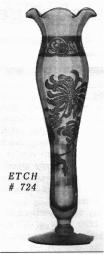National Depression Glass Association
Preserving America's Glass Manufacturing Heritage
Cambridge Betty - the Mystery Etching
by Mark Nye
Glass Review - March 1987
Of the several Cambridge etchings utilizing girls' names, one could
be called the "mystery girl", this being the etching known as Betty.
The current article will by no means resolve the mystery; it will only
 state the known facts. More "evidence" must be found before the mystery
of Betty is resolved.
state the known facts. More "evidence" must be found before the mystery
of Betty is resolved.

Betty was advertised in the March 1920 issue of Crockery and Glass and, at that time, described as new. There is little reason to doubt the etching was brought out at about that time or perhaps a couple of months earlier at the Pittsburgh Show. Betty appeared on two pages in a Cambridge catalog issued in 1920 or early the next year and available items consisted of vases, a jug and a tumbler. When it was first produced, the etching was done only on Crystal blanks as the age of color had yet to arrive at Cambridge.
There were twelve different vases being offered in the early 1920s and when all the various sizes are totaled, 29 separate vases were available with the Betty etching. Anyone wishing a real challenge should attempt to assemble a collection of all 29. I doubt if it can be done but I might be wrong.
As can be seen in the illustration, the Betty etching consists of readily distinguishable large flowers and leaves along with a rim border consisting of a repetitive small leaf and flower design (see the two vases at right).
Now the mystery begins. On the same catalog page that illustrated the Betty jug, there is shown the No. 98 77 ounce jug and cover along with a 12 oz. tumbler, both etched, according to the catalog, "P.E. 523." (P.E. standing for Plate Etching.) Nothing startling about this except for the fact that etching No. 523 appears to be the same as Betty! The only discernible difference is the fact that the border part of the etching does not appear on the body of the jug; rather, it is on the lid.
One possible explanation for this is, as is true in other instances, perhaps this etching had a popular name as well as a factory assigned number and the number was inadvertently used in place of the name in both the catalog and price list.
However, it is entirely possible there are subtle differences
between Betty and P.E. 523 that are not readily seen in the catalog
 illustrations (see photo below, left).
illustrations (see photo below, left).
The plot thickens and our mystery lady becomes even more mysterious as it would appear during the late 1920s. Appearing on a catalog page dating to the fall of 1928 are three vases captioned as being etched No. 724. Now No. 724 (at right) appears to be very similar if not identical to Betty and two of the three vases are the same ones that were shown on the original catalog page showing Betty!
What is this, a new disguise? The border is gone but the etching "Chrys" (perhaps a shortened version of chrysanthemum) certainly looks like Betty. The first references we have for Chrys is a catalog page, this also issued in the fall of 1932, where it is shown on an ice bucket. The knowledge we have regarding the etching numbering and naming schemes used by Cambridge would support the theory that Chrys is in fact Betty without the border etching.
In the 1930 Cambridge catalog, we once again get to see Etchings No. 724 and Chrys. The illustrations are quite clear and we get a good look at both etchings. Chrys appears on an ice pail (at left), a covered jug and a tumbler while E. 724 shows up on five different vases. After allowances for positioning the etching on items of varying shapes and sizes, the only readily discernible difference between the two is the border used as part of No. 724. There does not appear to be any difference between No. 724 as it is shown in this catalog and Betty as it originally appeared in the early 1920s.
The Betty etching including all its variants and look-alikes, such as they may be, was apparently discontinued at some point during the 1930s as none appear in the 1940 or later catalogs.
Chrys and No. 724 were no doubt made in most, if not all, of the prevailing pastel colors of the later 1920s and early 1930s as well as some of the darker colors such as Amber and Amethyst. Chrys has been seen on Emerald (light) and Peach-blo jugs. As Betty and Etching No. 523, production may have been limited to Crystal.
Are there differences between Betty, P.E. 523, Etching No. 724 and Chrys, other than the presence or absence of borders, and if so, what are they? In the proverbial "ten words or less," I simply do not know. This group of etchings is infrequently seen and thus there is great difficulty in becoming familiar with a sufficient number of items to discern any differences, significant or minute. Perhaps when all of Cambridge etching plates obtained at the time of the Imperial liquidation are cleaned and examined in detail, we will solve the mystery of Betty.
Until then, Betty, the mysterious Cambridge lady, remains an enigma.